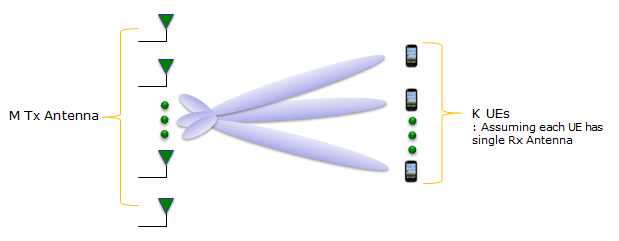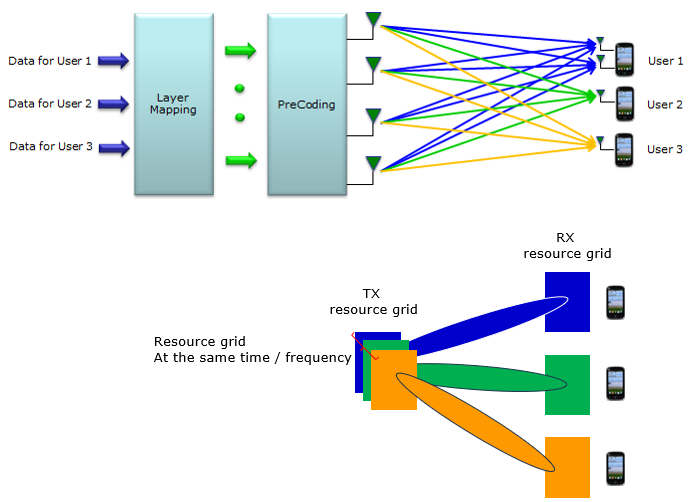|
|
||
|
MU-MIMO stands for Multi User MIMO. It means Performing MIMO for more than 2 UEs simultaneously as illustrated below. This is not a new concept. We have MU-MIMO in current LTE (TM5) and WLAN (802.11ad). However, the scale of MU-MIMO will be much larger and deployment will also be more common. As far as I experienced, I haven't seen any case where TM5 is really used in current LTE live network. In case of 802.11ad, the distance between UE and transmitter antenna is designed to be very short comparing to 5G network. So real implementation of MU-MIMO for 5G will be much more challenging.
There are many aspects we need to consider in terms of MU-MIMO implementations and understandings on fundamental concepts.
ChallengesHow challenging it would be to implement MU-MIMO ? The answer would be different depending on many factors. Even with the same number of users and same number of Tx/Rx antenna, there can be different mode of antenna allocation as illustrated below. There can be several factors to be considered in MU-MIMO implementation as follows.
High level view of implementationThere can be many different ways to implement the MU MIMO and just a few high level view can be illustrated as below.
Mathematical Model for MU-MIMOMathematical Model for MU-MIMO for 5G would vary depending on how you implement the MU-MIMO. As far as I know, for now the detailed MU-MIMO implementation is up to gNB manufacturer and not specified in 3GPP. But general idea would be similar even though no vendor shares the detailed technical information to the public. I think all the mathemtical details for the single user MIMO and Beamforming would be helpful to understand the mathematical model for MU-MIMO. NOTE : You may want to have some simple math model, but there is no such a thing as simple model and simple math for this kind of issue. The only thing you can make it simpler is to do enough practice and get yourself to be familiar with basic math concepts related to the whole process. If you want start from something in 3GPP, the math behind type II codebook would be a good start
It is also good to have understandings on Precoding as well. Regardless of which one you refer to, you may need some basic understandings on what is the meaning of various matrix with complex number element. For these fundamental math pratice, you may check out following notes. I created these to give intuitive understandings on various math components which are commonly used to represents math models for Precoding, Beamforming etc.
Followings are the list of notes that I wrote to get myself familiar to the concept of beamforming.
Resource Allocation for MU-MIMOIf it works in ideal way as intended, the transmitter (gNB) should be able to transmit the data at the same (idential) time and frequency position for multiple recievers (UEs), meaning that the data (e.g, PDSCH) for the multiple UEs can be transmitted at the position of same slot and same subcarriers. How can this possible ? How the data for the multiple different UE can be transmitted at the same time and frequency location without interfering to each other ? One of important assumption for MU-MIMO would be that the transmitter (e.g, gNB) can do pricise and flexible beamforming and the receiving UEs are positioned far enough from each other in such a way that the beams targeted for different UEs does not interfer each other. In this condition, the signals for each UEs takes different path in physical spaces without interfering others even though they are transmitted from the same time and frequency location.
How throughput is impacted ?In case of SU-MIMO (Single User MIMO), we don't differentiate throughput of transmitter (gNB) and reciever(UE) because they are same. But for MU-MIMO, we need to consider the throughput for transmitter and reciever differently. In short, the max throughput for the reciever (UE) does not change. It is same as the max throughput of SU-MIMO, but the max throughput for the transmitter (gNB) multiples of SU-MIMO. Let's imagine an example of MU-MIMO illustrated below and assume that the all the data (blue, gree, orange) are transmitted at the same time / frequency locations. In this case, each of the UE is receiving the signal coming from only one resource (OFDM resource grid marked as a specific color) but the transmitter is transmitting multiple set of resource grids (marked as different colors) at the same time. This concept is well described and demonstrated in Buckle Up! T-Mobile Achieves Mind-Blowing 5G Speeds with MU-MIMO. Check out the video in the article.
Reference
|
||



